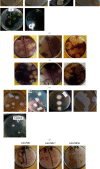In Vitro Evaluation of Extracellular Enzyme Activity and Its Biocontrol Efficacy of Bacterial Isolates from Pepper Plants for the Management of Phytophthora capsici
- PMID: 36199757
- PMCID: PMC9529479
- DOI: 10.1155/2022/6778352
In Vitro Evaluation of Extracellular Enzyme Activity and Its Biocontrol Efficacy of Bacterial Isolates from Pepper Plants for the Management of Phytophthora capsici
Abstract
Phytophthora capsici is one of the most devastating fungal pathogens, causing severe diseases that lead to economic loss in the pepper industry. As a result of the infections, the chemical approach is becoming more popular. Biological control, on the other hand, is better suited to controlling fungal pathogens. The biological control approach significantly reduces the problems associated with chemical applications while restoring natural environmental balance. As a result, the overall findings indicate that certain bacterial isolates play a beneficial role in lytic enzyme production and biocontrol activities against P. capsici. Bacterial isolates obtained from the pepper plants were screened for lytic enzyme and anti-oomycete activity against Phytophthora capsici in Ethiopia. Sixty bacterial isolates were isolated and tested against Phytophthora capsici. From these bacterial isolates, different inhibition zones and hydrolytic enzyme production were detected. Biochemical tests using an automated machine (MALDI-TOF, VITEK 2 compact and 16S rRNA) revealed that three of them, AAUSR23, AAULE41, and AAULE51, showed a high inhibition zone and high production of hydrolytic enzymes and were identified as Enterobacter cloacae (AAUSR23), Pseudomonas fluorescens (AAULE41), and undetermined (AAULE51). The effects of diffusable metabolite isolate AAULE51 has a 66.7% inhibition zone against Phytophthora capsici, followed by AAULE41 and AAUSR23, which have 59.7% and 14.1% inhibition zones, respectively. These bacterial isolates showed high production of hydrolytic enzymes like protease, cellulase, chitinase, and lipase (5-34 diameter of inhibition zone). As a result, the overall findings show that selected bacterial isolates play a beneficial role in lytic enzyme production and for their biocontrol activities against P. capsici.
Copyright © 2022 Mesele Admassie et al.
Conflict of interest statement
The authors declare that they have no competing interests.
Figures






Similar articles
-
Evaluation of biocontrol efficacy of rhizosphere Pseudomonas aeruginosa for management of Phytophthora capsici of pepper.PLoS One. 2024 Sep 20;19(9):e0309705. doi: 10.1371/journal.pone.0309705. eCollection 2024. PLoS One. 2024. PMID: 39302985 Free PMC article.
-
Endophytic bacterial flora in root and stem tissues of black pepper (Piper nigrum L.) genotype: isolation, identification and evaluation against Phytophthora capsici.Lett Appl Microbiol. 2009 Jan;48(1):58-64. doi: 10.1111/j.1472-765X.2008.02486.x. Epub 2008 Nov 14. Lett Appl Microbiol. 2009. PMID: 19018963
-
Biocontrol ability of Lysobacter antibioticus HS124 against Phytophthora blight is mediated by the production of 4-hydroxyphenylacetic acid and several lytic enzymes.Curr Microbiol. 2009 Dec;59(6):608-15. doi: 10.1007/s00284-009-9481-0. Epub 2009 Aug 29. Curr Microbiol. 2009. PMID: 19727949
-
The oomycete broad-host-range pathogen Phytophthora capsici.Mol Plant Pathol. 2012 May;13(4):329-37. doi: 10.1111/j.1364-3703.2011.00754.x. Epub 2011 Oct 20. Mol Plant Pathol. 2012. PMID: 22013895 Free PMC article. Review.
-
Challenges and Strategies for Breeding Resistance in Capsicum annuum to the Multifarious Pathogen, Phytophthora capsici.Front Plant Sci. 2018 May 15;9:628. doi: 10.3389/fpls.2018.00628. eCollection 2018. Front Plant Sci. 2018. PMID: 29868083 Free PMC article. Review.
Cited by
-
Screening of heavy metal-resistant rhizobial and non-rhizobial microflora isolated from Trifolium sp. growing in mining areas.Environ Monit Assess. 2024 Feb 19;196(3):283. doi: 10.1007/s10661-024-12445-0. Environ Monit Assess. 2024. PMID: 38372826
-
Evaluation of biocontrol efficacy of rhizosphere Pseudomonas aeruginosa for management of Phytophthora capsici of pepper.PLoS One. 2024 Sep 20;19(9):e0309705. doi: 10.1371/journal.pone.0309705. eCollection 2024. PLoS One. 2024. PMID: 39302985 Free PMC article.
-
Fermentation of waste water from agar processing with Bacillus subtilis by metabolomic analysis.Appl Microbiol Biotechnol. 2024 Dec;108(1):15. doi: 10.1007/s00253-023-12891-9. Epub 2024 Jan 3. Appl Microbiol Biotechnol. 2024. PMID: 38170310
-
Biocontrol Potential of Bacillus velezensis RS65 Against Phytophthora infestans: A Sustainable Strategy for Managing Tomato Late Blight.Microorganisms. 2025 Mar 14;13(3):656. doi: 10.3390/microorganisms13030656. Microorganisms. 2025. PMID: 40142548 Free PMC article.
-
Biocontrol and Growth Promotion of Rice by Pseudomonas aeruginosa SNTKU16: Beneficial Properties and Genomic Potential.J Microbiol Biotechnol. 2025 Feb 14;35:e2411067. doi: 10.4014/jmb.2411.11067. J Microbiol Biotechnol. 2025. PMID: 39947704 Free PMC article.
References
-
- Sagar A., Yadav S., Sayyed R., Sharma S., Ramteke P. Bacillus subtilis: a multifarious plant growth promoter, biocontrol agent, and bioalleviator of abiotic stress. Bacilli in Agrobiotechnology; 2022; Cham. pp. 561–580. - DOI
-
- Joshua J., Mmbaga M. T. Potential biological control agents for Soilborne fungal pathogens in Tennessee snap bean farms. HortScience . 2020;55(7):988–994. doi: 10.21273/HORTSCI14081-19. - DOI
-
- Zhao J., Xue Q. H., Shen G. H., Xue L., Duan J. L., Wang D. S. Evaluation of Streptomyces spp. for biocontrol of gummy stem blight (Didymella bryoniae) and growth promotion of Cucumis melo L. Biocontrol Science and Technology . 2012;22(1):23–37. doi: 10.1080/09583157.2011.636481. - DOI
MeSH terms
Substances
LinkOut - more resources
Full Text Sources
Research Materials

